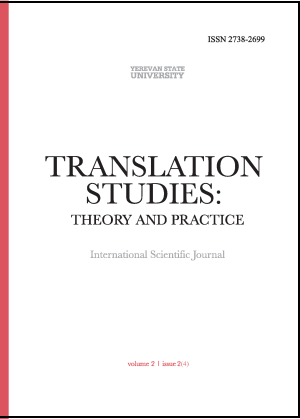Translations of English Children’s Literature in the Armenian Periodicals in India
DOI:
https://doi.org/10.46991/TSTP/2022.2.2.048Keywords:
translation, children’s literature, Armenian communities, periodicalsAbstract
Translations had a significant role both in the popularization of Eastern Armenian and the establishment of literary and cultural ties between the Armenian community and the British. The purpose was to further the international outlook, understanding and emotional experience of foreign environments and cultures, on the one hand, next was to make more literature available to children and to contribute to the development of the readers’ set of values.
It should be noted that literary relations first of all contributed to the emergence of bilingual dictionaries. Shmavonian published an English-Armenian dictionary which was intended “for the entertainment of studious children” (Mkhitaryan 2016:81).
19th century was marked by social political changes and created conditions for the development of new Armenian literature which was so important for shaping the mind set and behavior of the Armenian children. Thus, Armenian translators translated literature in connection with social and economic forces.
The Armenian printing business in India operated for a century and published almost 200 books, booklets and more than ten periodicals. In this article some translations published in Azdarar (The Intelligencer, 1794, Madras), Azgaser (the Patriot, 1845, Calcutta), Azgaser Araratian (Patriot Araratian, 1848. Calcutta), and Hayeli Kalkatian (Mirror of Calcutta, 1820, Calcutta) are examined.
References
Addison, Joseph. 1870. Addison’s Essays from the Spectator. London: William Tegg. https://books.google.am/books?id=sVvakdU5cKQC&hl=hy&pg=PR3#v=onepage&q&f=false
Asiatic Journal and Monthly Register for British and Foreign India, China and Australasia. 1822. “Brief Account of the Armenian Press.” Vol. 14, pp. 347-349.
Aslanian, Maro. 1982. “Russoyi angliatsi hetevordy “Azdarari” ejerum” [the English Follower of Rousseau in the Columns of “Azdarar”]. Historical-Philological Journal, vol. 3: 96-109. Yerevan: the Armenian branch of the USSR Academy of Sciences.
Aslanian, Maro. 1985. Angliatsi heghinakner Addisoni and Steeli patmvatsqnery “Azdararum” [Short Stories by English Writers Addison and Steele in “Azdarar”], vol. 1:160-168. Yerevan: the Armenian branch of the USSR Academy of Sciences.
Aslanian, Sebouh. 2014. Port Cities and Printers: Reflections on Early Modern Modal Global Culture 1512-1800. Vol. 7: 51-93. Accessed August 13, 2022. https://history.ucla.edu/sites/default/files/17.aslanian- libre.pdf
Avdalian, Hovhannes. 1858. Speech by Mr. Hovhannes Addressed to the Board Members of Armenian Philanthropic Society, pp. 31-33. Venice, St. Lazzaro.
Azdarar. 1795. Vol. 7, pp. 143-144.
Bakhchinyan, Artsvi. 2015. “The Activity of Armenian Merchants in International Trade.” Regional Routes, Regional Roots? Cross-Border Patterns of Human Mobility in Eurasia, no. 14, pp. 23-29. Accessed August 27, 2022. https://src-h.slav.hokudai.ac.jp/rp/publications/no14/14-03_Bakhchinyan.pdf
Baladouni, Vahé, and Margaret Makepeace. 1998. “Armenian Merchants of the Seventeenth and Early Eighteenth Centuries: English East India Company Sources.” Transactions of the American Philosophical Society Held at Philadelphia for Promoting Useful Knowledge, vol. 88(5): 281-294, https://doi.org/10.2307/1006664. Philadelphia: American Philosophical Society.
Chaudhuri, Supriya. 2012. “The Bengali Novel.” The Cambridge Companion to Modern Indian Culture. (eds.) Vasudha Dalmia and Rashmi Sadana, pp. 101-123. Cambridge: Cambridge University Press.
Day, Thomas. 1822. The History of Little Jack. London: Dean & Son.
Govindarajan, Vinita. 2017. Paper Trail: How the World’s First Armenian Journal Emerged in Madras in 1794. Accessed August 24, 2022. https://scroll.in/magazine/845597/paper-trail-how-the-worlds-first-armenian-journal-emerged-in-madras-in-1794
Hussain, Ruquia. 2010. “Armenian Renaissance and Safavid Peace.” Proceedings of the Indian History Congress, vol. 71, pp. 921–27. Accessed September 15, 2022. http://www.jstor.org/stable/44147560.
Hussain, Ruquia. 2013. “Armenian Merchants in India Trade from French Sources.” Proceedings of the Indian History Congress, vol. 74 , pp. 269–76. Accessed 3 Sep. 2022. http://www.jstor.org/stable/44158825
Mkhitaryan, Margo. 2016. Hayeren arajin parberakany ev nra khmbagiry [First Armenian-Language Periodical and Its Editor]. Yerevan: YSU Publishing House.
Morley, Henry. 1891. The Spectator. A New Edition Reproducing the Original Text Both as First Issued and as Corrected by its Authors with Introduction, Notes, and Index, vol. 1. London: G. Routledge & Sons.
Patterson, Sylvia Wiese. 1969. The Influence of Rousseau’s ‘Emile’ upon the Writers of Children’s Books in the Late Eighteenth Century. The Florida State University ProQuest Dissertations Publishing.
Porteus, Beilby. 1850. A Summary of the Principal Evidences for the Truth and Divine Origin of the Christian Revelation. Edinburgh:po A. and C. Black.
Sanjian, Ara. 2012. Celebrating the Legacy of Five Centuries of Armenian-Language Book Printing, 1512-2012. Michigan: University of Michigan-Dearborn.
Seth, Mesrovb. 1937. Armenians in India, from the Earliest Times to the Present Day: A Work of Original Research. Madras: Asian Educational Services.
Vasset, Sophie. 2019. “Robinson Crusoe and the Aesthetic of Survival.” Études anglaises, vol. 72, pp. 225-240.
Wolff, Joseph. 1837. Researches and Missionary Labours among the Jews, Mohammedans, and Other Sects. Philadelphia, O. Rogers. Accessed September 17, 2022. https://www.loc.gov/item/31008997/
Downloads
Published
How to Cite
Issue
Section
License
Copyright (c) 2022 Varduhi Baloyan

This work is licensed under a Creative Commons Attribution-NonCommercial 4.0 International License.










